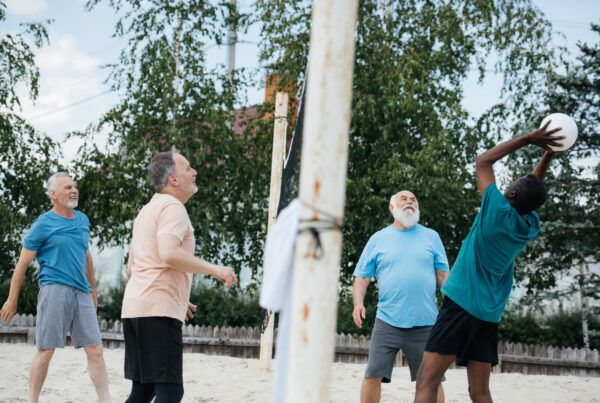”Question: How do I maintain a consistent exercise habit?
Reading time: 6 Minutes
MWi Hack:
- Learn about what is behind a consistent exercise routine and how to change behavior and make habits permanent.
MWi Summary:
-
- Behavior change is the process of changing behaviors to better fit your goals.
- The stages of behavior change include pre contemplation, contemplation, preparation, action, maintenance, and termination.
- Positive psychology, SMART goals, self-determination theory, and rewards are other tools to help you move through the stages of behavior change.
Behavior change is the process of changing certain behaviors like habits to make room for new ones or to give up ones that are not serving you. When it comes to fitness and health, creating sustainable, lasting behaviors is essential for maintaining your healthy habits and reaching your goals.
Creating goals can quickly become overwhelming, especially if you are unsure where to start. It is also common for people to jump in headfirst and try to take on too much change at once, leaving them feeling stressed. When this happens, it often leads to giving up altogether.
The key to behavior change in fitness is using some tried and true methods based on psychology. These methods slowly and incrementally build up for less stressful or overwhelming transitions in your lifestyle habits. Below we help you make sense of the stages of behavior change as well as equip you with some methods to try as you implement change.
Stages of Behavior Change
Making a lasting change in behavior is rarely a quick or easy process. In fact, if you want to make changes that last it helps to recognize that it will involve a commitment to your goals as well as the time, effort, and emotion to make it happen.
It also helps to understand the stages of change that people go through. Overall, there are six main stages of behavior change that most people go through on their journey.1 These include precontemplation, contemplation, preparation, action, maintenance, and termination or relapse. Here is a closer look at each of those stages.
Precontemplation
The precontemplation stage is the period before you are ready to make changes. This phase usually occurs at least 6 months before you will be prepared to change your current behaviors and patterns. Perhaps you are not aware of how undesirable your current lifestyle is, or you do not feel like making changes is necessary.
Contemplation
During contemplation, you are starting to plan to make changes in the near future. You have weighed the pros and cons of making changes or staying the same and have decided that change is necessary. However, you may still feel some ambivalence toward changing and are not quite ready yet.
Preparation
This is the 30-day countdown period toward change. You have made up your mind to make some alterations in your lifestyle and habits so that you can work toward healthier choices. You believe that change is necessary and are starting to take small steps toward achieving it.
Action
You have been making changes in this stage for up to 6 months. This is still early in the game, and you need to be vigilant and purposeful as the healthier habits are still new.
Maintenance
The maintenance phase is when you have been successfully acting out your new behaviors and have made lasting changes for more than 6 months now. What’s important now is avoiding relapse and making sure the changes you have made stick.
Termination or Relapse
Termination is the point where you have no desire to return to your past behaviors. It is the ultimate goal of lasting behavior change. Relapse is also common when behavior change has failed to be permanent.
While relapse is avoidable, it does happen. Trying out different methods for behavior change can help you discover what works for you. Ideally, you will not relapse, but if you do, or if you are currently in that phase, do not be discouraged—this is normal, and you can start over.
Methods of Behavior Change
Psychologists use a few methods for creating lasting behavior change that you can pull from during your journey toward your fitness and health goals. Here are some ideas that you can draw from as you work toward change.
Positive Psychology
Positive psychology is the practice of focusing on your strengths and not your deficits or weaknesses. With positive psychology, the idea is to practice gratitude and optimism about your past, be content with the present, and have hope for your future.2
The idea is to create an environment and lifestyle that supports your behavior change by focusing on your strengths and building on them, rather than trying to “fix” the things you believe are weaknesses.
It is a mindset shift that encourages positive thinking about yourself, your abilities, and your progress, rather than focusing on what you believe you are doing “wrong.” One way to put this into practice is to start a gratitude journal. In the journal, you can write down your accomplishments, what your body provides you, and what you are thankful for.
SMART Goals
Using SMART goals is a classic method of making behavior change last. The way to implement SMART goals is to make them:
- Specific: Create specific habits that lead to your outcome. Instead of saying, “I want to get stronger,” try saying, “I want to lift weights for 45 minutes each morning four times per week.”
- Measurable: Make sure your goal is trackable and measurable, and then keep track of your progress. For instance, track how many times per week you complete your goal of lifting weights and measure your results by keeping a log of your weights lifted or time spent exercising and how you have gotten better over time.
- Attainable: The goals you choose should be achievable. Choose short-term, reasonable goals for your habits, such as “I will increase my deadlift weight by 10 pounds each week.” The goal you choose should be ambitious and challenge you without feeling too intimidating.
- Relevant: Your goals and habits should be relevant to your preferences. For instance, if you have no interest in lifting more for a deadlift, choose something else that makes sense to you and motivates you. Maybe you want to complete more pushups in a row or decrease back pain. The goal should excite you and keep you pushing toward achievement.
- Time-bound: Choose a timeframe in which you will reach your goal. This timeframe should be reasonable and not too far in the future. Start with a few weeks ahead, rather than a whole year, for instance. Once the time is up, re-evaluate your goal and set new ones.
Self-Determination Theory
Self-determination theory is the idea that a person’s ability to make choices for and manage their life is within their grasp. In other words, a person believes that they are capable of change and that they control their behaviors.3
When you believe you are in control, you are more likely to be motivated to take action toward the changes you want, and you recognize you can affect the results with your actions.
People with self-determination also understand that they are responsible for their successes and their failures. One of the best ways to help you achieve self-determination is to find social support.
Find a workout buddy or accountability partner that you can work with. Supportive social environments boost motivation and increase self-determination. Avoid situations and people that discourage you or do not offer positive support.
Rewards
Using rewards is tricky because relying heavily on them can backfire. The best way to use rewards to reach your fitness goals is to pick something that will not only encourage you but also help you maintain your habits when you are newly building them.
Once you have the practice in place, back off from using rewards because they can actually decrease your natural motivation.4
If you have no interest in participating in your new habit, such as strength training, yet you know you want to and should do it, using a reward can help you get there. Once you participate in the habit, the idea is that you will find internal (intrinsic) motivation to continue it.
This type of motivation works better for sustaining your habit and includes internal motivators like noticing how great you feel after your workout and acknowledging that you look and feel stronger. It also might mean noticing your increased energy, better sleep habits, and other reinforcing feelings. Recognizing these things keeps you looking forward to your workouts.5
How to Maintain Your New Behaviors
Maintaining your motivation and new behaviors is vital for lasting change. The maintenance phase includes avoiding your previous undesired behaviors while continuing your new ones.6 Setting yourself up for success from the start will make you less likely to relapse.
If you have chosen a workout buddy or accountability partner, they can help you stay on track. Check-in with one another and be open about your struggles. Look for encouragement from your buddy to keep you on track, whether that is making gym dates and sticking to them or reporting to them about your successes and failures.
Review your gratitude journal to remind yourself of all the positives that come with maintaining your new behaviors. You can also write out a cons list of all the things you will miss out on if you revert to old habits.
If you have been tracking and measuring your goals, look back and see how far you have come and what you have been able to accomplish.
Keep reviewing your goals to see if they are relevant to you and if they are attainable. Reviewing and adjusting your SMART goals is part of the ongoing process—they are not set-it-and-forget-it but an evolving set of ambitions to work toward. Changing them and adapting them as you go is helpful and provides you with more self-determination because you know you are in charge.






